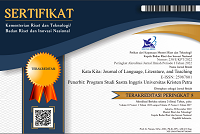TEACHER’S INTERACTIONAL MODIFICATIONS AND THE STUDENTS’ RESPONSES IN INTERMEDIATE ENGLISH CLASSROOM
DOI:
https://doi.org/10.9744/katakita.5.1.60-68Keywords:
, Operating System, Windows, Ubuntu, PXE.Abstract
This study is about the teacher’s interactional modifications in teaching the intermediate students in an English Course in Surabaya. The three objectives of this study are to find out the types of the teacher’s interactional modifications, the students’ responses toward the teacher’s interactional modifications, and the contribution of the interactional modifications for the students’ learning. The subject of the data is an English teacher and fourteen students. Moreover, the theory applied was a theory of the interactional modifications from William, Inscoe, and Tasker (2014). The findings revealed that the teacher used five types of interactional modifications namely confirmation check, clarification request, comprehension check, repetition, and reformulation. While for the students’ responses, it showed that the students gave correct responses, incorrect responses, and no responses. Furthermore, it also revealed that interactional modifications gave four contributions; making the meaning more comprehensible for the learners, improving the learners’ language, minimizing the misunderstanding between the teacher and the learners, and ensuring that the learners were following. Finally, the writer concluded that the interactional modifications help the learners to learning the language
References
Gass, S. M., Mackey, A., & Pica T. (1998). The Role of Input and Interaction in Second Language Acquisition: Introduction to the Special Issue. The Modern Language Journal, 82 (3), 299-305.
Lynch, T. (1997). Communication in the Language Classroom. Oxford: Oxford University Press.
Lynch, T. (2009). Teaching Second Language Listening. Oxford: Oxford University
Press.
Walsh, S. (2006). Investigating Classroom Discourse. New York: Routledge
Walsh, S. (2011). Exploring Classroom Discourse: Language in Action. New York:
Routledge
William, J. Incoe, R. & Tasker, T. (2014). Communication strategies in an interactional context: the mutual achievement of comprehension. In Communication Strategies: Psycholinguistic and Sociolinguistic Perspectives. (pp 304-322). New York: Routledge
Zacharias, N. T. (2011). Qualitative research methods for second language education: A coursebook. Cambridge Scholars Publishing.
Downloads
Issue
Section
License
Authors who publish with this journal agree to the following terms:- Authors retain copyright and grant the journal right of first publication with the work simultaneously licensed under a Creative Commons Attribution License that allows others to share the work with an acknowledgement of the work's authorship and initial publication in this journal.
- Authors are able to enter into separate, additional contractual arrangements for the non-exclusive distribution of the journal's published version of the work (e.g., post it to an institutional repository or publish it in a book), with an acknowledgement of its initial publication in this journal.
- Authors are permitted and encouraged to post their work online (e.g., in institutional repositories or on their website) prior to and during the submission process, as it can lead to productive exchanges, as well as earlier and greater citation of published work (See The Effect of Open Access).














